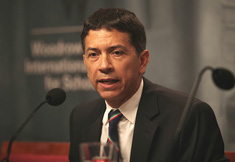-
Understanding Climate Vulnerability: José Miguel Guzmán on How Census and Survey Data Can Help Us Plan
November 15, 2013 By Laura Henson
“Population-related data from census, surveys, and other administrative data can and must be used for adaptation to climate change,” says José Miguel Guzmán in this week’s podcast from the launch of The Demography of Adaptation to Climate Change. As the devastation from Typhoon Haiyan shows, population density, poverty levels, and even building construction quality can have a huge impact on how vulnerable a particular area is to extreme weather, flooding, and other effects of climate change.
“Population-related data from census, surveys, and other administrative data can and must be used for adaptation to climate change,” says José Miguel Guzmán in this week’s podcast from the launch of The Demography of Adaptation to Climate Change. As the devastation from Typhoon Haiyan shows, population density, poverty levels, and even building construction quality can have a huge impact on how vulnerable a particular area is to extreme weather, flooding, and other effects of climate change.
There’s a wealth of existing socioeconomic and geographic data that can help determine human vulnerability and fill critical gaps in climate research, according to Guzmán, regional coordinator of demographic health surveys at ICF International, an international consulting company. But it’s often in different places or unavailable to the general public, including other researchers.
Guzmán and his team work to aggregate data from disparate sources, classifying by common vulnerability indicators, such as household income, and physical, household-specific indicators, such as air conditioning. Finally, the team organizes each indicator further into one of three categories: demographic, human and social capital, or the built environment.
“What we propose here is a need to recreate, reprocess, or rearrange existing individual and household data to map and analyze the differential vulnerabilities and adaptive capacities to climate change impacts,” he says.
For example, many countries have already built poverty maps by linking household income surveys with census data, he says. The same can be done with climate change and socioeconomic data to develop resilience indicators; understand vulnerability; and inform planning, monitoring, and evaluation of adaptation programming.
“[The data is] available, but in order to use [it] effectively for planning for adaptation and building resilient communities, cities, and countries, we need first to identify and define which are the best indicators and know how we can use them in a consistent framework,” Guzmán explains.
“This is an important area of research and practical work that can help to connect the dots between individual and community adaptation; between demography and geography; and between environment and population dynamics.”
Guzmán spoke at the Wilson Center on October 2. Download his slides to follow along.
Friday podcasts are also available for download on iTunes.
 A Publication of the Stimson Center.
A Publication of the Stimson Center.




